 Now I’ll tell you why we don’t do ballooning in this country in the winter. Its mainly because its dark, cold, wet and windy, an argument totally supported by weather conditions at five o’clock in the morning on Saturday 15th February when we went to celebrate the long-awaited re-opening of the stunningly beautiful Oxford University Natural History Museum. It had been advertised as a Dawn to Dusk event, clearly to take in the stunning glass panelled roof that dominates (figure of speak, it doesn’t somehow) that had been lovingly removed, cleaned and replaced to cure the many leaks that had dogged the museum and were in danger of starting to seriously affect the exhibits.
Now I’ll tell you why we don’t do ballooning in this country in the winter. Its mainly because its dark, cold, wet and windy, an argument totally supported by weather conditions at five o’clock in the morning on Saturday 15th February when we went to celebrate the long-awaited re-opening of the stunningly beautiful Oxford University Natural History Museum. It had been advertised as a Dawn to Dusk event, clearly to take in the stunning glass panelled roof that dominates (figure of speak, it doesn’t somehow) that had been lovingly removed, cleaned and replaced to cure the many leaks that had dogged the museum and were in danger of starting to seriously affect the exhibits. 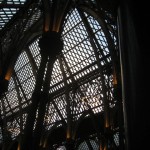 Bazzer had spotted the announcement some weeks previously and as it is both of our favourite building the opportunity to be amongst the first through the doors at seven o’clock could not be missed. Jane elected not to join us with the excuse that as we were off to Francais the following day someone had to sort out the dogs, do the packing and get in provisions as part of the care in the community thing. I think it was just well too early and she feared the morning would drag out and we would adjourn to The King’s Arms. She had a point.
Bazzer had spotted the announcement some weeks previously and as it is both of our favourite building the opportunity to be amongst the first through the doors at seven o’clock could not be missed. Jane elected not to join us with the excuse that as we were off to Francais the following day someone had to sort out the dogs, do the packing and get in provisions as part of the care in the community thing. I think it was just well too early and she feared the morning would drag out and we would adjourn to The King’s Arms. She had a point.
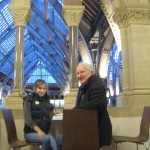 The wind was, to say the least, ferocious, and the A41 to Bicester, en-route to collect Barry, looked like a war zone. There were trees, panelled fencing and road works bits everywhere. The trusty little Corsa made it through though, clearly practising for its mega trip the following day. We made it into Oxford for about quarter to seven and with heads down against flying twigs and branches managed to make it to the front door, well and truly bolted shut in a Medieval sort of way despite the fact the building is Victorian. We were very much the first there and not a little concerned lest we had the wrong day or time but we needn’t have worried as pretty soon a small gaggle of brave souls including members of a bizarre interweb camera club had joined us and, bless her,
The wind was, to say the least, ferocious, and the A41 to Bicester, en-route to collect Barry, looked like a war zone. There were trees, panelled fencing and road works bits everywhere. The trusty little Corsa made it through though, clearly practising for its mega trip the following day. We made it into Oxford for about quarter to seven and with heads down against flying twigs and branches managed to make it to the front door, well and truly bolted shut in a Medieval sort of way despite the fact the building is Victorian. We were very much the first there and not a little concerned lest we had the wrong day or time but we needn’t have worried as pretty soon a small gaggle of brave souls including members of a bizarre interweb camera club had joined us and, bless her,  a small girl being towed by her granddad. As the wind whistled, warmth, mumbles, laughter and giggles emanated from within and fortunately moments later, just as the giant redwood threatened to bend totally in half, the doors were unbolted, unlocked and creakingly opened. The small child was ushered forward and swamped by happy smiling museum staff and photographers for pictures as the first in. After over a year’s closure The Oxford University Natural History Museum was open again. We all cheered, its that sort of place, not library or whispered respect at all.
a small girl being towed by her granddad. As the wind whistled, warmth, mumbles, laughter and giggles emanated from within and fortunately moments later, just as the giant redwood threatened to bend totally in half, the doors were unbolted, unlocked and creakingly opened. The small child was ushered forward and swamped by happy smiling museum staff and photographers for pictures as the first in. After over a year’s closure The Oxford University Natural History Museum was open again. We all cheered, its that sort of place, not library or whispered respect at all.
 If you’ve never visited before let me explain that the somewhat grand but unremarkable exterior hides one of the most eclectic bits of neo-Gothic architecture inside which has remained unchanged since it was opened in 1860. Built to house the University’s scientific collections of zoological, entomological and geological specimens it is everything Victorian achievement and no sooner had it opened it hosted the famous 1860 Huxley-Wilberforce debate on Darwin’s, then recently-published, theories of evolution by natural selection. Of course it was typical that within a few years it was proving too small to accommodate studies as well and the professors moved into bigger premises nearby but it remained a working museum. To my mind the inside is a wonder of the World. It is laid out with aisles, a gallery, columns and glass roof and it seems to be completely random giving you a different perspective depending how you look at it but, truth is, its layout is really remarkably mathematical. Having said that no two bits of decoration or columns are the same. Its simply marvellous. The glass roof has been its downfall though and last year the money was finally found to properly overhaul it. The light inside was always special but the exhibits, cases and the glass panels were all showing their age and needed, to be frank, a jolly good clean and
If you’ve never visited before let me explain that the somewhat grand but unremarkable exterior hides one of the most eclectic bits of neo-Gothic architecture inside which has remained unchanged since it was opened in 1860. Built to house the University’s scientific collections of zoological, entomological and geological specimens it is everything Victorian achievement and no sooner had it opened it hosted the famous 1860 Huxley-Wilberforce debate on Darwin’s, then recently-published, theories of evolution by natural selection. Of course it was typical that within a few years it was proving too small to accommodate studies as well and the professors moved into bigger premises nearby but it remained a working museum. To my mind the inside is a wonder of the World. It is laid out with aisles, a gallery, columns and glass roof and it seems to be completely random giving you a different perspective depending how you look at it but, truth is, its layout is really remarkably mathematical. Having said that no two bits of decoration or columns are the same. Its simply marvellous. The glass roof has been its downfall though and last year the money was finally found to properly overhaul it. The light inside was always special but the exhibits, cases and the glass panels were all showing their age and needed, to be frank, a jolly good clean and  makeover. That is exactly what they have done. All the 8,500 glass tiles were taken off, cleaned and replaced using modern sealants then the columns, rafters and general fabric of the inside of the building were cleaned. Exhibits and display cases were cleaned and new lighting fitted. The result is stupendous. What were interesting but somewhat drab displays are now sparkling and clear. The transformation is astonishing not least because nothing has really changed. What was lovely was the staff loved the transformation.
makeover. That is exactly what they have done. All the 8,500 glass tiles were taken off, cleaned and replaced using modern sealants then the columns, rafters and general fabric of the inside of the building were cleaned. Exhibits and display cases were cleaned and new lighting fitted. The result is stupendous. What were interesting but somewhat drab displays are now sparkling and clear. The transformation is astonishing not least because nothing has really changed. What was lovely was the staff loved the transformation.
 To be in a building like this when it is almost empty is a rare privilege. We wandered around taking in the exhibits, patted the Shetland pony and sauntered orf to say hello again to the dinosaurs. Part of the gallery has been given over to a café which had only been finished late the evening before. It is set against the wall so doesn’t impede a meander around the exhibits at this level. We sat and had a coffee and looked down on the growing number of visitors that were now arriving. This upper gallery, let me explain, puts you on a level with the pre-historic skeletons suspended from the roof and also the tops of the main columns where they spread out to take the weight of the roof, spandrels don’t you know. These are decorated with wrought iron leaves, ferns and plants, all different, the effect is magical.
To be in a building like this when it is almost empty is a rare privilege. We wandered around taking in the exhibits, patted the Shetland pony and sauntered orf to say hello again to the dinosaurs. Part of the gallery has been given over to a café which had only been finished late the evening before. It is set against the wall so doesn’t impede a meander around the exhibits at this level. We sat and had a coffee and looked down on the growing number of visitors that were now arriving. This upper gallery, let me explain, puts you on a level with the pre-historic skeletons suspended from the roof and also the tops of the main columns where they spread out to take the weight of the roof, spandrels don’t you know. These are decorated with wrought iron leaves, ferns and plants, all different, the effect is magical. 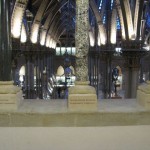 The columns that run round the gallery are equally impressive each one being made from a different type of named British decorative rock with limestone capitals carved with various plants and animals. The amount of work that went into the detail explains why it took five years to build. There was fierce opposition when it was originally proposed but the sheer determination of Henry Acland saw building work start in 1855. The chosen architect was Benjamin Woodward of the Dublin-based form Deane and Woodward who bought over the O’Shea brothers to carry out the majority of the carvings until the money ran out,
The columns that run round the gallery are equally impressive each one being made from a different type of named British decorative rock with limestone capitals carved with various plants and animals. The amount of work that went into the detail explains why it took five years to build. There was fierce opposition when it was originally proposed but the sheer determination of Henry Acland saw building work start in 1855. The chosen architect was Benjamin Woodward of the Dublin-based form Deane and Woodward who bought over the O’Shea brothers to carry out the majority of the carvings until the money ran out, 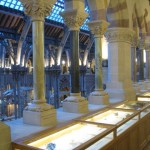 which is why some of the external carvings around the windows on the front of the building are unfinished. The painted decoration extends to the girders and beams themselves. Embellishment and decoration is everywhere and, if you pay attention, you will see some of it is very amusing. The great thing is that it has not been restored, just cleaned, so is, in a way, probably pretty much as it was first conceived. I have to say that in my opinion you do need at least two visits one for the exhibits and one for the building. Luckily entry is free.
which is why some of the external carvings around the windows on the front of the building are unfinished. The painted decoration extends to the girders and beams themselves. Embellishment and decoration is everywhere and, if you pay attention, you will see some of it is very amusing. The great thing is that it has not been restored, just cleaned, so is, in a way, probably pretty much as it was first conceived. I have to say that in my opinion you do need at least two visits one for the exhibits and one for the building. Luckily entry is free.
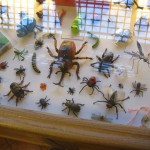 I could go on and on about the exhibits themselves but suffice to say that they are predominately local and set out in a proper museum way, not in the now popular tourist inter-active big labels and gaudy arrows minimalist way that many museums these days have subcummed to. There are the fabulous huge fossil remains of dinosaurs dominated by Stan the Tyrannosaurus Rex with a huge fossilised dinosaur head full of teeth below that usually has a small child in its jaws. On a gentler note there is a well patted Shetland pony and skeletons of whales and dolphins. The cases are packed full of interesting clearly labelled stuff. Look closely and you will find bits of humour everywhere from a cabinet full of toy bugs to a jade elephant in amongst examples of crystal. Children are not dissuaded from touching and steps are provided so that they can see in when needed. There are a few cabinets containing live specimens, cockroaches, a tarantula and various other bugs plus an active beehive that takes a bit of finding and if you time it right a closed circuit TV broadcasts live from the swifts’ nests up in the tower. I discovered a wonderful mahogany seed and a really old crab.
I could go on and on about the exhibits themselves but suffice to say that they are predominately local and set out in a proper museum way, not in the now popular tourist inter-active big labels and gaudy arrows minimalist way that many museums these days have subcummed to. There are the fabulous huge fossil remains of dinosaurs dominated by Stan the Tyrannosaurus Rex with a huge fossilised dinosaur head full of teeth below that usually has a small child in its jaws. On a gentler note there is a well patted Shetland pony and skeletons of whales and dolphins. The cases are packed full of interesting clearly labelled stuff. Look closely and you will find bits of humour everywhere from a cabinet full of toy bugs to a jade elephant in amongst examples of crystal. Children are not dissuaded from touching and steps are provided so that they can see in when needed. There are a few cabinets containing live specimens, cockroaches, a tarantula and various other bugs plus an active beehive that takes a bit of finding and if you time it right a closed circuit TV broadcasts live from the swifts’ nests up in the tower. I discovered a wonderful mahogany seed and a really old crab. 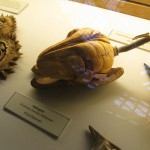 One of my favourite set of cabinets describes the local soils and rocks that can be found in the area along with fossils found in them and examples of buildings and products made from them. It really does get the younger folk interested in an otherwise rather dull subject. That’s the thing about this museum, it is children friendly big-time but before you imagine screaming devils charging about that doesn’t seem to happen. By now the light was flooding in and the roof was filled with birdsong from the rainforest and the sound of excited but amazingly well-behaved kids chatting and laughing. It does that.
One of my favourite set of cabinets describes the local soils and rocks that can be found in the area along with fossils found in them and examples of buildings and products made from them. It really does get the younger folk interested in an otherwise rather dull subject. That’s the thing about this museum, it is children friendly big-time but before you imagine screaming devils charging about that doesn’t seem to happen. By now the light was flooding in and the roof was filled with birdsong from the rainforest and the sound of excited but amazingly well-behaved kids chatting and laughing. It does that. 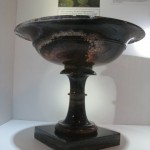 Two hours had flown by. We wandered around the ground floor one last time and had a very pleasant chat to the girls in the foyer, looked back in awe at the bright roof and bade our farewells. You can be sure we’ll be returning soon with grandchildren in tow no doubt. We won’t tell Jane about the huge Blue John vase otherwise she may opt for a late visit! I read later that they had over 5,000 visitors during the first day’s Dawn to Dusk opening.
Two hours had flown by. We wandered around the ground floor one last time and had a very pleasant chat to the girls in the foyer, looked back in awe at the bright roof and bade our farewells. You can be sure we’ll be returning soon with grandchildren in tow no doubt. We won’t tell Jane about the huge Blue John vase otherwise she may opt for a late visit! I read later that they had over 5,000 visitors during the first day’s Dawn to Dusk opening.
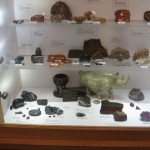 One interesting thing I did discover that made me chuckle was that although clearly the place is built along the lines of a cathedral what I never realised was that the building to the right, which I’d always assumed pre-dated the museum and I kind of always ‘recognised’ from somewhere, was actually built as part of the Museum as a laboratory. It is known as the Abbot’s Kitchen and turns out that it was built with extra thick walls lest there be an
One interesting thing I did discover that made me chuckle was that although clearly the place is built along the lines of a cathedral what I never realised was that the building to the right, which I’d always assumed pre-dated the museum and I kind of always ‘recognised’ from somewhere, was actually built as part of the Museum as a laboratory. It is known as the Abbot’s Kitchen and turns out that it was built with extra thick walls lest there be an  explosion or two and tall chimneys to carry away ‘noxious’ fumes. It looked familiar because it is based on the Abbot’s Kitchen at Glastonbury. On that note we headed round the corner for a pint of Meantime and a bacon sandwich. Sadly The Kings Arms wasn’t open. Oxford wakes up slowly, so we reckoned on Georginas, a well kept secret upstairs small café in the covered market which do rather splendid bacon loaves and, rather appropriately, sports the same name (nearly – Ed.) as Barry’s daughter.
explosion or two and tall chimneys to carry away ‘noxious’ fumes. It looked familiar because it is based on the Abbot’s Kitchen at Glastonbury. On that note we headed round the corner for a pint of Meantime and a bacon sandwich. Sadly The Kings Arms wasn’t open. Oxford wakes up slowly, so we reckoned on Georginas, a well kept secret upstairs small café in the covered market which do rather splendid bacon loaves and, rather appropriately, sports the same name (nearly – Ed.) as Barry’s daughter.
http://www.oum.ox.ac.uk/
http://www.bbc.co.uk/news/uk-england-oxfordshire-26055962